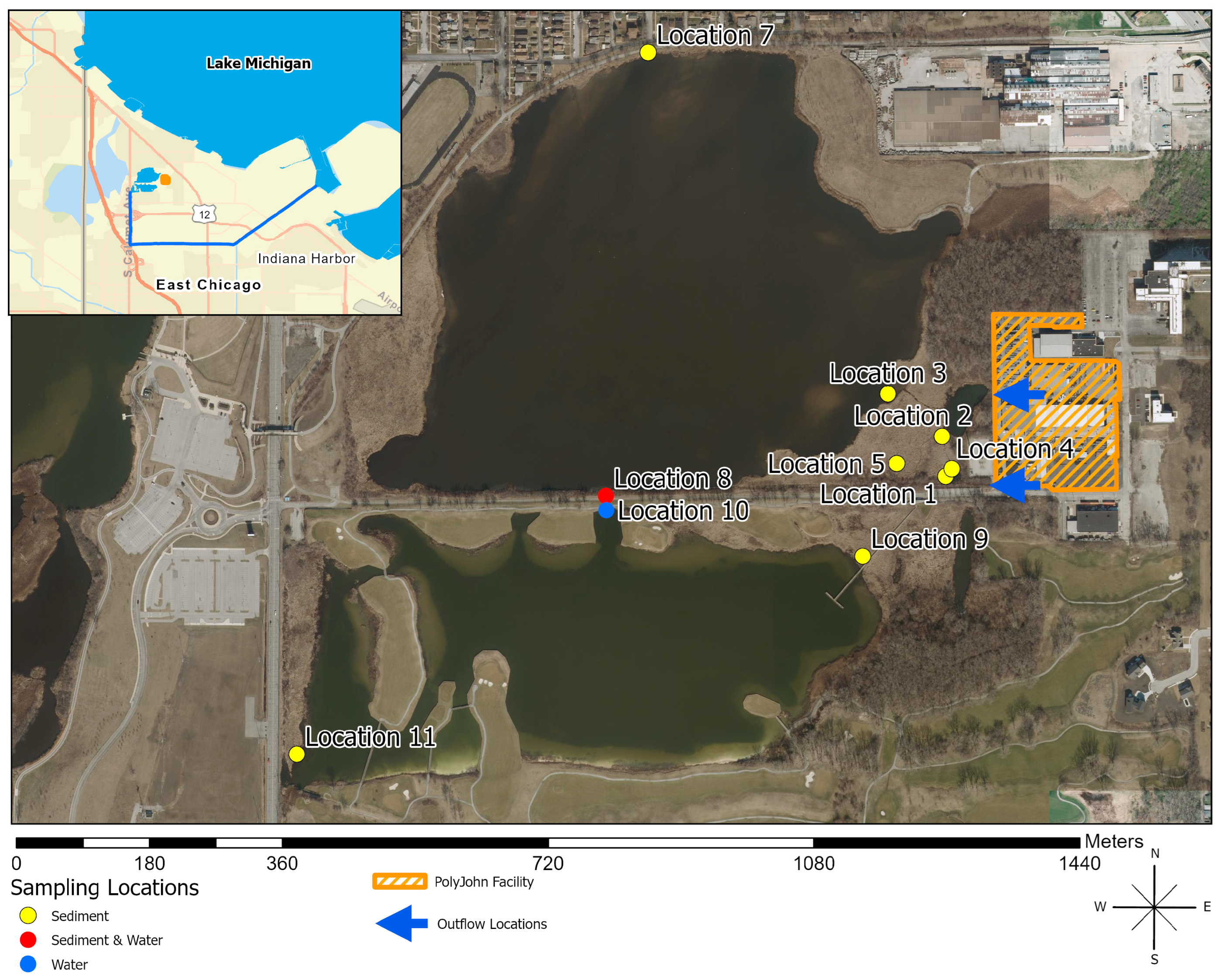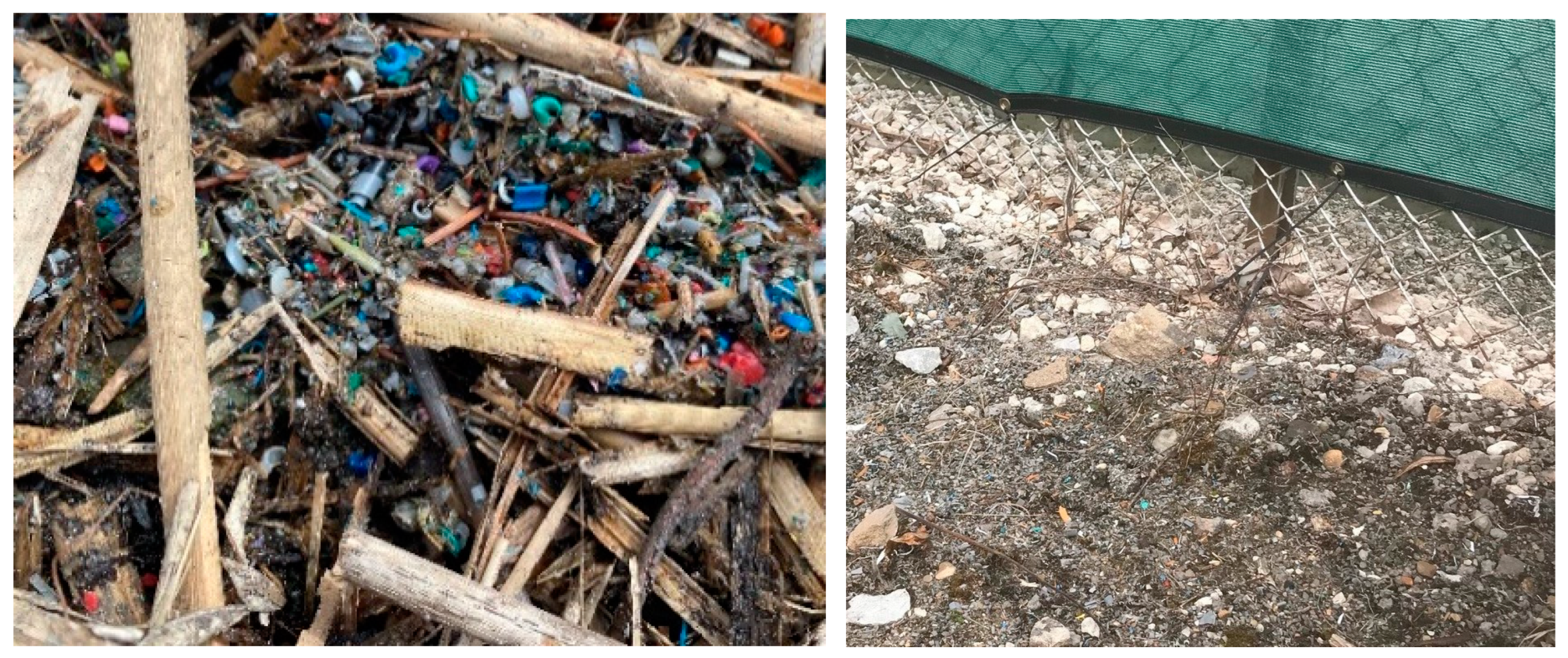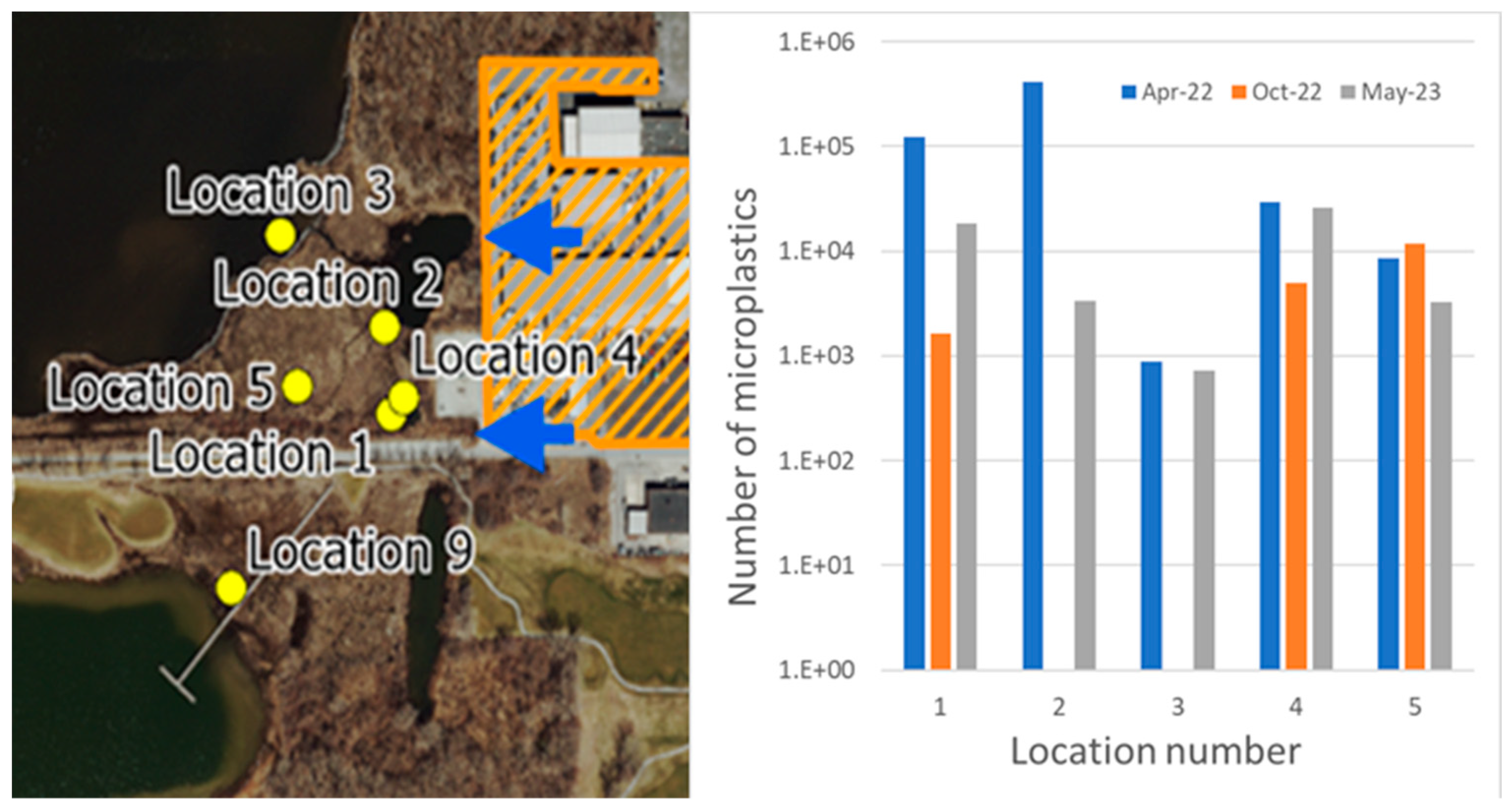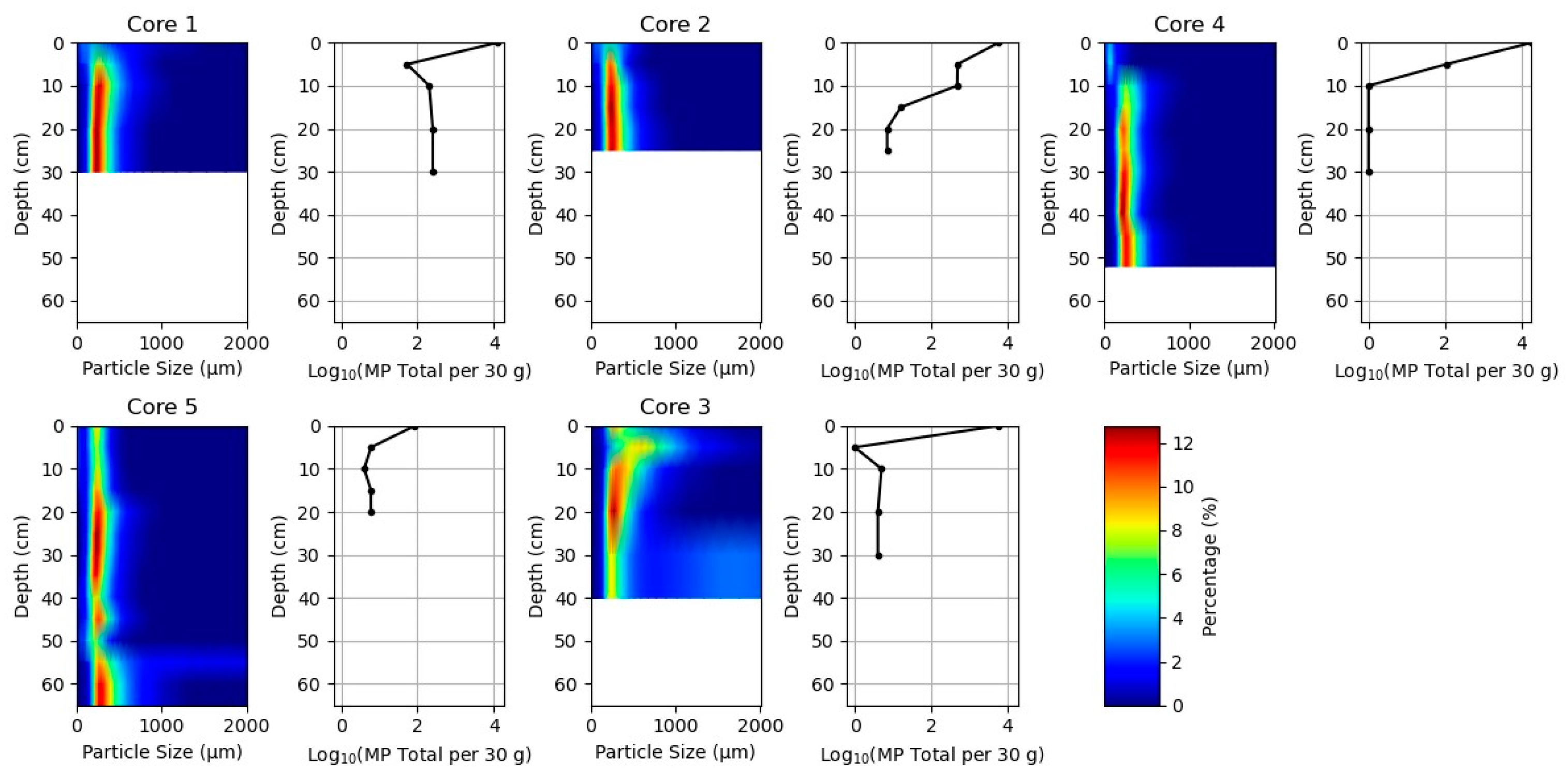Distribution and Fate of Polyethylene Microplastics Released by a Portable Toilet Manufacturer into a Freshwater Wetland and Lake
Abstract
:1. Introduction
2. Materials and Methods
2.1. Study Sites

2.2. Sample Collections
2.3. Laboratory Processing of Field Samples
2.4. Quantification and Characterization of Microplastics and Soil Particles
2.5. Lab-Scale Remediation of Microplastics in Natural Water
2.6. Data Analysis and Maps
3. Results
3.1. Point Source Polyethylene Microplastics Pollution Detection and Material Verification
3.2. Quantification of Microplastics in Water, Sediment, and Air Samples
3.3. Sediment Depth Sampling and Air Monitoring
3.4. Potential Remediation Methodology for MP Contamination in Surface Waters
3.5. Study Limitations
4. Conclusions
Supplementary Materials
Author Contributions
Funding
Data Availability Statement
Acknowledgments
Conflicts of Interest
References
- Barrett, J.; Chase, Z.; Zhang, J.; Holl, M.M.B.; Willis, K.; Williams, A.; Hardesty, B.D.; Wilcox, C. Microplastic Pollution in Deep-Sea Sediments from the Great Australian Bight. Front. Mar. Sci. 2020, 7, 808. [Google Scholar] [CrossRef]
- Van Cauwenberghe, L.; Claessens, M.; Vandegehuchte, M.B.; Mees, J.; Janssen, C.R. Assessment of marine debris on the Belgian Continental Shelf. Mar. Pollut. Bull. 2013, 73, 161–169. [Google Scholar] [CrossRef]
- Peller, J.; Nevers, M.B.; Byappanahalli, M.; Nelson, C.; Babu, B.G.; Evans, M.A.; Kostelnik, E.; Keller, M.; Johnston, J.; Shidler, S. Sequestration of microfibers and other microplastics by green algae, Cladophora, in the US Great Lakes. Environ. Pollut. 2021, 276, 116695. [Google Scholar] [CrossRef]
- Villanova-Solano, C.; Hernandez-Sanchez, C.; Diaz-Pena, F.J.; Gonzalez-Salamo, J.; Gonzalez-Pleiter, M.; Hernandez-Borges, J. Microplastics in snow of a high mountain national park: El Teide, Tenerife (Canary Islands, Spain). Sci. Total Environ. 2023, 873, 162276. [Google Scholar] [CrossRef]
- Li, W.X.; Chen, X.F.; Li, M.Q.; Cai, Z.M.; Gong, H.; Yan, M.T. Microplastics as an aquatic pollutant affect gut microbiota within aquatic animals. J. Hazard. Mater. 2022, 423, 127094. [Google Scholar] [CrossRef] [PubMed]
- Yin, L.S.; Wen, X.F.; Huang, D.L.; Du, C.Y.; Deng, R.; Zhou, Z.Y.; Tao, J.X.; Li, R.J.; Zhou, W.; Wang, Z.Y.; et al. Interactions between microplastics/nanoplastics and vascular plants. Environ. Pollut. 2021, 290, 117999. [Google Scholar] [CrossRef] [PubMed]
- Ragusa, A.; Matta, M.; Cristiano, L.; Matassa, R.; Battaglione, E.; Svelato, A.; De Luca, C.; D’Avino, S.; Gulotta, A.; Rongioletti, M.C.A.; et al. Deeply in Plasticenta: Presence of Microplastics in the Intracellular Compartment of Human Placentas. Int. J. Environ. Res. Public Health 2022, 19, 11593. [Google Scholar] [CrossRef]
- Alimi, O.S.; Budarz, J.F.; Hernandez, L.M.; Tufenkji, N. Microplastics and Nanoplastics in Aquatic Environments: Aggregation, Deposition, and Enhanced Contaminant Transport. Environ. Sci. Technol. 2018, 52, 1704–1724. [Google Scholar] [CrossRef] [PubMed]
- Enfrin, M.; Dumee, L.F.; Lee, J. Nano/microplastics in water and wastewater treatment processes—Origin, impact and potential solutions. Water Res. 2019, 161, 621–638. [Google Scholar] [CrossRef]
- Peller, J.R.; Eberhardt, L.; Clark, R.; Nelson, C.; Kostelnik, E.; Iceman, C. Tracking the distribution of microfiber pollution in a southern Lake Michigan watershed through the analysis of water, sediment and air. Environ. Sci. Process. Impacts 2019, 21, 1549–1559. [Google Scholar] [CrossRef]
- Buteler, M.; Fasanella, M.; Alma, A.M.; Silva, L.I.; Langenheim, M.; Tomba, J.P. Lakes with or without urbanization along their coasts had similar level of microplastic contamination, but significant differences were seen between sampling methods. Sci. Total Environ. 2023, 866, 161254. [Google Scholar] [CrossRef]
- Saling, P.; Gyuzeleva, L.; Wittstock, K.; Wessolowski, V.; Griesshammer, R. Life cycle impact assessment of microplastics as one component of marine plastic debris. Int. J. Life Cycle Assess. 2020, 25, 2008–2026. [Google Scholar] [CrossRef]
- Jarlskog, I.; Stromvall, A.M.; Magnusson, K.; Galfi, H.; Bjorklund, K.; Polukarova, M.; Garcao, R.; Markiewicz, A.; Aronsson, M.; Gustafsson, M.; et al. Traffic-related microplastic particles, metals, and organic pollutants in an urban area under reconstruction. Sci. Total Environ. 2021, 774, 145503. [Google Scholar] [CrossRef]
- De-la-Torre, G.E.; Dioses-Salinas, D.C.; Pizarro-Ortega, C.I.; Santillan, L. New plastic formations in the Anthropocene. Sci. Total Environ. 2021, 754, 142216. [Google Scholar] [CrossRef] [PubMed]
- Katare, Y.; Singh, P.; Sankhla, M.S.; Singhal, M.; Jadhav, E.B.; Parihar, K.; Nikalje, B.T.; Trpathi, A.; Bhardwaj, L. Microplastics in Aquatic Environments: Sources, Ecotoxicity, Detection & Remediation. Biointerface Res. Appl. Chem. 2022, 12, 3407–3428. [Google Scholar] [CrossRef]
- Pandey, B.; Pathak, J.; Singh, P.; Kumar, R.; Kumar, A.; Kaushik, S.; Thakur, T.K. Microplastics in the Ecosystem: An Overview on Detection, Removal, Toxicity Assessment, and Control Release. Water 2023, 15, 51. [Google Scholar] [CrossRef]
- Xu, S.; Ma, J.; Ji, R.; Pan, K.; Miao, A.J. Microplastics in aquatic environments: Occurrence, accumulation, and biological effects. Sci. Total Environ. 2020, 703, 134699. [Google Scholar] [CrossRef]
- Moyo, S. An enigma: A meta-analysis reveals the effect of ubiquitous microplastics on different taxa in aquatic systems. Front. Environ. Sci. 2022, 10, 999349. [Google Scholar] [CrossRef]
- Yano, K.A.; Geronimo, F.K.; Reyes, N.J.; Kim, L.H. Characterization and comparison of microplastic occurrence in point and non-point pollution sources. Sci. Total Environ. 2021, 797, 148939. [Google Scholar] [CrossRef]
- Galafassi, S.; Nizzetto, L.; Volta, P. Plastic sources: A survey across scientific and grey literature for their inventory and relative contribution to microplastics pollution in natural environments, with an emphasis on surface water. Sci. Total Environ. 2019, 693, 133499. [Google Scholar] [CrossRef]
- Shruti, V.C.; Perez-Guevara, F.; Elizalde-Martinez, I.; Kutralam-Muniasamy, G. Current trends and analytical methods for evaluation of microplastics in stormwater. Trends Environ. Anal. Chem. 2021, 30, e00123. [Google Scholar] [CrossRef]
- Yao, Y.; Glamoclija, M.; Murphy, A.; Gao, Y. Characterization of microplastics in indoor and ambient air in northern New Jersey. Environ. Res. 2022, 207, 112142. [Google Scholar] [CrossRef] [PubMed]
- Liu, C.G.; Li, J.; Zhang, Y.L.; Wang, L.; Deng, J.; Gao, Y.; Yu, L.; Zhang, J.J.; Sun, H.W. Widespread distribution of PET and PC microplastics in dust in urban China and their estimated human exposure. Environ. Int. 2019, 128, 116–124. [Google Scholar] [CrossRef] [PubMed]
- Wilkens, J.L.; McQueen, A.D.; LeMonte, J.J.; Suedel, B.C. Initial Survey of Microplastics in Bottom Sediments from United States Waterways. Bull. Environ. Contam. Toxicol. 2020, 104, 15–20. [Google Scholar] [CrossRef] [PubMed]
- Peller, J.R.; McCool, J.P.; Watters, M. Microplastics in Soils and Sediment: Sources, Methodologies, and Interactions with Microorganisms. In Handbook of Microplastics in the Environment; Rocha-Santos, T., Costa, M., Mouneyrac, C., Eds.; Springer Nature: Cham, Switzerland, 2020. [Google Scholar]
- Corradini, F.; Meza, P.; Eguiluz, R.; Casado, F.; Huerta-Lwanga, E.; Geissen, V. Evidence of microplastic accumulation in agricultural soils from sewage sludge disposal. Sci. Total Environ. 2019, 671, 411–420. [Google Scholar] [CrossRef] [PubMed]
- Kedzierski, M.; Cirederf-Boulant, D.; Palazot, M.; Yvin, M.; Bruzaud, S. Continents of plastics: An estimate of the stock of microplastics in agricultural soils. Sci. Total Environ. 2023, 880, 163294. [Google Scholar] [CrossRef] [PubMed]
- Kye, H.; Kim, J.; Ju, S.; Lee, J.; Lim, C.; Yoon, Y. Microplastics in water systems: A review of their impacts on the environment and their potential hazards. Heliyon 2023, 9, e14359. [Google Scholar] [CrossRef]
- Bujaczek, T.; Kolter, S.; Locky, D.; Ross, M.S. Characterization of microplastics and anthropogenic fibers in surface waters of the North Saskatchewan River, Alberta, Canada. Facets 2021, 6, 26–43. [Google Scholar] [CrossRef]
- Sewwandi, M.; Amarathunga, A.A.D.; Wijesekara, H.; Mahatantila, K.; Vithanage, M. Contamination and distribution of buried microplastics in Sarakkuwa beach ensuing the MV X-Press Pearl maritime disaster in Sri Lankan sea. Mar. Pollut. Bull. 2022, 184, 114074. [Google Scholar] [CrossRef]
- X-Press Pearl Maritime Disaster: Sri Lanka—Report of the UN Environmental Advisory Mission. 2021. Available online: https://www.unep.org/resources/report/x-press-pearl-maritime-disaster-sri-lanka-report-un-environmental-advisory-mission (accessed on 20 May 2023).
- Li, B.W.; Su, L.; Zhang, H.B.; Deng, H.; Chen, Q.Q.; Shi, H.H. Microplastics in fishes and their living environments surrounding a plastic production area. Sci. Total Environ. 2020, 727, 138662. [Google Scholar] [CrossRef]
- Jiang, X.T.; Conner, N.; Lu, K.J.; Tunnell, J.W.; Liu, Z.F. Occurrence, distribution, and associated pollutants of plastic pellets (nurdles) in coastal areas of South Texas. Sci. Total Environ. 2022, 842, 156826. [Google Scholar] [CrossRef]
- Karlsson, T.M.; Arneborg, L.; Brostrom, G.; Almroth, B.C.; Gipperth, L.; Hassellov, M. The unaccountability case of plastic pellet pollution. Mar. Pollut. Bull. 2018, 129, 52–60. [Google Scholar] [CrossRef] [PubMed]
- Massoels, R. NPDES Industrial Facility Inspection Report; Indiana Department of Environmental Management: Columbia City, IN, USA, 6 October 2020. [Google Scholar]
- Cooper, K. Response to April 27, 2021 Inspection Summary/Enforcement Referral in Management. 2021. Available online: https://www.in.gov/idem/oe/cause/AO/27426-W.htm (accessed on 20 May 2023).
- Willis, K.A.; Eriksen, R.; Wilcox, C.; Hardesty, B.D. Microplastic Distribution at Different Sediment Depths in an Urban Estuary. Front. Mar. Sci. 2017, 4, 419. [Google Scholar] [CrossRef]
- Cassio, F.; Batista, D.; Pradhan, A. Plastic Interactions with Pollutants and Consequences to Aquatic Ecosystems: What We Know and What We Do Not Know. Biomolecules 2022, 12, 798. [Google Scholar] [CrossRef]
- Talbot, R.; Chang, H.J. Microplastics in freshwater: A global review of factors affecting spatial and temporal variations. Environ. Pollut. 2022, 292, 118393. [Google Scholar] [CrossRef] [PubMed]
- Mettler, M.C. Demand for Payment of Stipulated Penalty: Commissioner of the Department of Environmental Management vs PolyJohn Enterprises Corporation; Indiana Department of Management: Indianapolis, IN, USA, 2021. [Google Scholar]
- Raman, R.K.; Lin, S.D.; Hullinger, D.L.; Bogner, W.C.; Slowikowski, J.A.; Roadcap, G.S. Diagnostic-Feasibility Study of Lake George, Lake County, Indiana; Illinois State Water Survey: Champaign, IL, USA, 1996. [Google Scholar]
- The U.S. Environmental Protection Agency (USEPA). Federated Metals Corp Whiting. Hammond, in Cleanup Activities. Available online: https://cumulis.epa.gov/supercpad/SiteProfiles/index.cfm?fuseaction=second.Cleanup&id=0501275#bkground (accessed on 20 May 2023).
- The U.S. Environmental Protection Agency (USEPA). EPA Proposes the Federated Metals Corp. Whiting Site in Hammond, Indiana to be Added to the Superfund National Priorities List to Protect Public Health from Contamination; The U.S. Environmental Protection Agency (USEPA): Washington, DC, USA, 2023. [Google Scholar]
- Luo, H.W.; Liu, C.Y.; He, D.Q.; Xu, J.; Sun, J.Q.; Li, J.; Pan, X.L. Environmental behaviors of microplastics in aquatic systems: A systematic review on degradation, adsorption, toxicity and biofilm under aging conditions. J. Hazard. Mater. 2022, 423, 126915. [Google Scholar] [CrossRef]
- Peller, J.R.; Mezyk, S.P.; Shidler, S.; Castleman, J.; Kaiser, S.; Horne, G.P. The Reactivity of Polyethylene Microplastics in Water under Low Oxygen Conditions Using Radiation Chemistry. Water 2021, 13, 3120. [Google Scholar] [CrossRef]
- Burt, R. Soil Survey Investigations Report No. 51; U.S. Department of Agriculture, Natural Resources Conservation Service: Washington, DC, USA, 2014. [Google Scholar]
- Elovitz, M.S.; Shemer, H.; Peller, J.R.; Vinodgopal, K.; Sivaganesan, M.; Linden, K.G. Hydroxyl radical rate constants: Comparing UV/H2O2 and pulse radiolysis for environmental pollutants. J. Water Supply Res. Technol.-AQUA 2008, 57, 391–401. [Google Scholar] [CrossRef]
- Schindelin, J.; Arganda-Carreras, I.; Frise, E.; Kaynig, V.; Longair, M.; Pietzsch, T.; Cardona, A. Fiji: An open-source platform for biological-image analysis. Nat. Methods 2012, 9, 676–682. [Google Scholar] [CrossRef]
- Peller, J.R. Methods for the Formation of Nanoplastics and the Agglomeration/Removal of Micro- and Nanoplastics in Water. U.S. Patent 18073783, 2 December 2022. [Google Scholar]
- PolyJohn. Available online: https://www.polyjohn.com/ (accessed on 2 August 2023).
- DeVore, M. IDEM finds more plastic pellets near PolyJohn site. Northwest Indiana Times, 3 April 2022. [Google Scholar]
- Massoels, R. Inspection Summary/Noncompliance Letter, PolyJohn, Lake County; Indiana Department of Environmental Management: Indianapolis, IN, USA, 2022. [Google Scholar]
- Prata, J.C.; Reis, V.; Paco, A.; Martins, P.; Cruz, A.; da Costa, J.P.; Duarte, A.C.; Rocha-Santos, T. Effects of spatial and seasonal factors on the characteristics and carbonyl index of (micro)plastics in a sandy beach in Aveiro, Portugal. Sci. Total Environ. 2020, 709, 135892. [Google Scholar] [CrossRef]
- Koutnik, V.S.; Leonard, J.; Brar, J.; Cao, S.Q.; Glasman, J.B.; Cowger, W.; Ravi, S.; Mohanty, S.K. Transport of microplastics in stormwater treatment systems under freeze-thaw cycles: Critical role of plastic density. Water Res. 2022, 222, 118950. [Google Scholar] [CrossRef]
- Cai, Y.M.; Li, C.; Zhao, Y.Q. A Review of the Migration and Transformation of Microplastics in Inland Water Systems. Int. J. Environ. Res. Public Health 2022, 19, 148. [Google Scholar] [CrossRef]
- Horton, A.A.; Dixon, S.J. Microplastics: An introduction to environmental transport processes. Wiley Interdiscip. Rev.-Water 2018, 5, e1268. [Google Scholar] [CrossRef]
- Sharma, S. Glassy Carbon: A Promising Material for Micro- and Nanomanufacturing. Materials 2018, 11, 1857. [Google Scholar] [CrossRef] [PubMed]
- Blettler, M.C.M.; Agustini, E.; Abrial, E.; Piacentini, R.; Garello, N.; Wantzen, K.M.; Vega, M.G.; Espinola, L.A. The challenge of reducing macroplastic pollution: Testing the effectiveness of a river boom under real environmental conditions. Sci. Total Environ. 2023, 870, 161941. [Google Scholar] [CrossRef] [PubMed]
- Helinski, O.K.; Poor, C.J.; Wolfand, J.M. Ridding our rivers of plastic: A framework for plastic pollution capture device selection. Mar. Pollut. Bull. 2021, 165, 112095. [Google Scholar] [CrossRef]
- Falk-Andersson, J.; Rognerud, I.; De Frond, H.; Leone, G.; Karasik, R.; Diana, Z.; Dijkstra, H.; Ammendolia, J.; Eriksen, M.; Utz, R.; et al. Cleaning Up without Messing Up: Maximizing the Benefits of Plastic Clean-Up Technologies through New Regulatory Approaches. Environ. Sci. Technol. 2023, 57, 13304–13312. [Google Scholar] [CrossRef] [PubMed]
- Fiore, M.; Garofalo, S.F.; Migliavacca, A.; Mansutti, A.; Fino, D.; Tommasi, T. Tackling Marine Microplastics Pollution: An Overview of Existing Solutions. Water Air Soil Pollut. 2022, 233, 276. [Google Scholar] [CrossRef]
- Schmaltz, E.; Melvin, E.C.; Diana, Z.; Gunady, E.F.; Rittschof, D.; Somarelli, J.A.; Virdin, J.; Dunphy-Daly, M.M. Plastic pollution solutions: Emerging technologies to prevent and collect marine plastic pollution. Environ. Int. 2020, 144, 106067. [Google Scholar] [CrossRef]
- Ali, I.; Tan, X.; Li, J.Y.; Peng, C.S.; Wan, P.; Naz, I.; Duan, Z.P.; Ruan, Y.L. Innovations in the Development of Promising Adsorbents for the Remediation of Microplastics and Nanoplastics-A Critical Review. Water Res. 2023, 230, 119526. [Google Scholar] [CrossRef]
- Rozman, U.; Kalcikova, G. The Response of Duckweed Lemna minor to Microplastics and Its Potential Use as a Bioindicator of Microplastic Pollution. Plants 2022, 11, 2953. [Google Scholar] [CrossRef] [PubMed]
- Rozman, U.; Kokalj, A.J.; Dolar, A.; Drobne, D.; Kalcikova, G. Long-term interactions between microplastics and floating macrophyte Lemna minor: The potential for phytoremediation of microplastics in the aquatic environment. Sci. Total Environ. 2022, 831, 154866. [Google Scholar] [CrossRef] [PubMed]
- Jiang, H.R.; Bu, J.Q.; Bian, K.; Su, J.M.; Wang, Z.Y.; Sun, H.; Wang, H.; Zhang, Y.S.; Wang, C.Q. Surface change of microplastics in aquatic environment and the removal by froth flotation assisted with cationic and anionic surfactants. Water Res. 2023, 233, 119794. [Google Scholar] [CrossRef] [PubMed]
- Miao, L.Z.; Gao, Y.X.; Adyel, T.M.; Huo, Z.L.; Liu, Z.L.; Wu, J.; Hou, J. Effects of biofilm colonization on the sinking of microplastics in three freshwater environments. J. Hazard. Mater. 2021, 413, 125370. [Google Scholar] [CrossRef]
- Cruz-Salas, A.A.; Velasco-Perez, M.; Mendoza-Munoz, N.; Vazquez-Morillas, A.; Beltran-Villavicencio, M.; Alvarez-Zeferino, J.C.; Ojeda-Benitez, S. Sorption of Total Petroleum Hydrocarbons in Microplastics. Polymers 2023, 15, 2050. [Google Scholar] [CrossRef]








Disclaimer/Publisher’s Note: The statements, opinions and data contained in all publications are solely those of the individual author(s) and contributor(s) and not of MDPI and/or the editor(s). MDPI and/or the editor(s) disclaim responsibility for any injury to people or property resulting from any ideas, methods, instructions or products referred to in the content. |
© 2023 by the authors. Licensee MDPI, Basel, Switzerland. This article is an open access article distributed under the terms and conditions of the Creative Commons Attribution (CC BY) license (https://creativecommons.org/licenses/by/4.0/).
Share and Cite
Peller, J.R.; Tabor, G.; Davis, C.; Iceman, C.; Nwachukwu, O.; Doudrick, K.; Wilson, A.; Suprenant, A.; Dabertin, D.; McCool, J.-P. Distribution and Fate of Polyethylene Microplastics Released by a Portable Toilet Manufacturer into a Freshwater Wetland and Lake. Water 2024, 16, 11. https://doi.org/10.3390/w16010011
Peller JR, Tabor G, Davis C, Iceman C, Nwachukwu O, Doudrick K, Wilson A, Suprenant A, Dabertin D, McCool J-P. Distribution and Fate of Polyethylene Microplastics Released by a Portable Toilet Manufacturer into a Freshwater Wetland and Lake. Water. 2024; 16(1):11. https://doi.org/10.3390/w16010011
Chicago/Turabian StylePeller, Julie R., Gavin Tabor, Christina Davis, Chris Iceman, Ozioma Nwachukwu, Kyle Doudrick, Antigone Wilson, Alyssa Suprenant, David Dabertin, and Jon-Paul McCool. 2024. "Distribution and Fate of Polyethylene Microplastics Released by a Portable Toilet Manufacturer into a Freshwater Wetland and Lake" Water 16, no. 1: 11. https://doi.org/10.3390/w16010011
APA StylePeller, J. R., Tabor, G., Davis, C., Iceman, C., Nwachukwu, O., Doudrick, K., Wilson, A., Suprenant, A., Dabertin, D., & McCool, J. -P. (2024). Distribution and Fate of Polyethylene Microplastics Released by a Portable Toilet Manufacturer into a Freshwater Wetland and Lake. Water, 16(1), 11. https://doi.org/10.3390/w16010011










